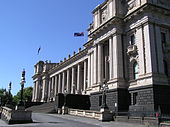The Local Government Act 2020 was a significant statute in Victoria, Australia, notable for its impact on the electoral systems of local councils in Victoria.[1] The Act, which the Victorian Government described as the "most ambitious and comprehensive reform of local government in Victoria for 30 years," will see a large number of multi-member wards replaced with single-member wards.[1][2]
| Local Government Act 2020 | |
|---|---|
 | |
| Parliament of Victoria | |
| |
| Citation | No. 9 of 2020 |
| Territorial extent | Victoria |
| Passed by | Legislative Assembly |
| Passed | 17 March 2020 |
| Passed by | Legislative Council |
| Passed | 5 March 2020 |
| Royal assent | 24 March 2020 |
| Commenced | 6 April 2020 |
| Effective | Various |
| Legislative history | |
| First chamber: Legislative Assembly | |
| Bill title | Local Government Bill 2019 |
| Introduced by | Marlene Kairouz |
| Introduced | 13 November 2019 |
| First reading | 13 November 2019 |
| Second reading | 14–28 November 2019 |
| Consideration in detail | 28 November 2019 |
| Third reading | 28 November 2019 |
| Second chamber: Legislative Council | |
| Bill title | Local Government Bill 2019 |
| Received from the Legislative Assembly | 28 November 2019 |
| Member(s) in charge | Adem Somyurek |
| First reading | 28 November 2019 |
| Second reading | 28 November 2019 – 3 March 2020 |
| Committee of the whole | 3–5 March 2020 |
| Third reading | 5 March 2020 |
| Final stages | |
| Legislative Council amendments considered by the Legislative Assembly | 17 March 2020 |
| Finally passed both chambers | 17 March 2020 |
| Amends | |
| No. 5 of 2001, No. 11 of 1989, No. 8887 of 1976, No. 68 of 2000, No. 5 of 2019, No. 62 of 2001, No. 115 of 1994, etc. | |
| Repeals | |
| No. 16 of 1993, No. 65 of 2009, No. 14 of 2016, No. 53 of 2013 | |
| Status: In force (amended) | |
Reviews were undertaken for the number of councillors, number of councillors per ward and the exact boundaries of those wards for 39 of Victoria's 79 councils.[2]
The Act was introduced on 17 June 2019 by the then-Minister for Local Government, Adem Somyurek.[3] It passed parliament on 17 March 2020, and received Royal Assent days later on 24 March.[1][4]
The Act has been criticised for its banning of proportional representation for most councils, and the consequential likely negative impact on the ability for women and minority groups to be elected.[5]
Councils affected
editAll metropolitan councils with multi-member wards were affected by the changes. Rural councils have the options of being unsubdivided, or having equal-sized multi-member wards.[5] The City of Melbourne, which is unsubdivided and does not have wards, was not impacted.[2]
Although most changes are set to come into effect before the 2024 local elections, eight councils moved to single-member wards ahead of the 2020 local elections:[6]
- Bayside City Council
- Cardinia Shire Council
- Darebin City Council
- Greater Dandenong City Council
- Kingston City Council
- Manningham City Council
- Maroondah City Council
- Whitehorse City Council
Additionally, Swan Hill and Mansfield moved to an unsubdivided structure.[6]
References
edit- ^ a b c "Local Government Act 2020". Local Government Victoria.
- ^ a b c Raue, Ben. "Victorian council ward reviews eradicating PR in Melbourne". The Tally Room.
- ^ "Delivering A New Local Government Act For Victoria". Premier of Victoria.
- ^ "Ratepayers want 'urgent structural overhaul' of councils". Herald Sun.
- ^ a b "Victorian local government review prompts concerns about female representation". ABC News.
- ^ a b "Electoral structure changes for 2020". Department of Government Services.